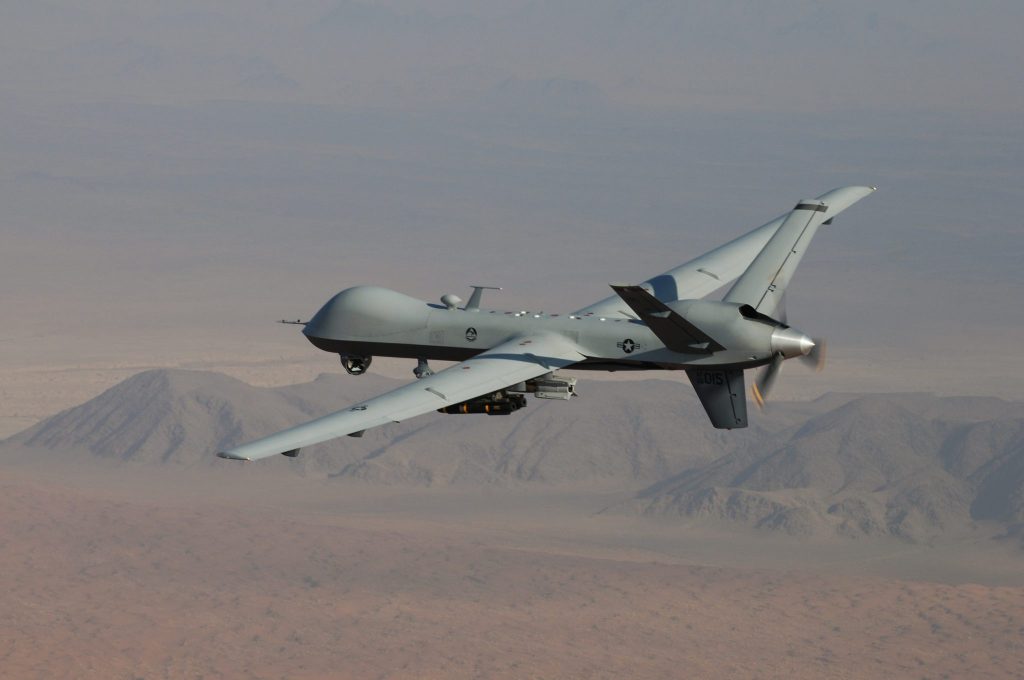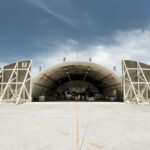The Abraham Accords effect: more armed drones in the Middle East
By Ali Arfa | April 29, 2021

Israel, the United Arab Emirates (UAE), and Bahrain signed a historic agreement to normalize relations in August 2020. Then-president Trump hailed the Abraham Accords, as the agreement is called, as a harbinger of peace in the volatile Middle East. Trump later tried to sweeten the deal with a $23 billion arms sale to the UAE.
After Biden was elected president, the deal’s future remained uncertain until mid-April, when a US State Department spokesman said the administration will approve the weapons sale. That means the UAE will soon have American-made armed Reaper drones in its arsenal.
Predictably enough, with or without Washington, security cooperation between Israel and the Arab signatories of the Abraham Accords waxes as hostilities and mutual distrust gradually wanes. This means an inevitable export of Israeli military technology to the Iranian neighborhood, with Tehran responding in kind, which will lead to the proliferation of unmanned combat aerial vehicles—and more specifically, armed drones, a pivotal military technology suitable for the light-footprint operations of today’s remote warfare. But if too many armed drones land at the Middle East’s door, peace may fly out its window.
Why more Israeli drones are coming. Armed drones are valuable assets for any military. They eliminate the risk of losing a pilot or special operator to the enemy. They reduce the time between target acquisition and strike, because they carry both sensor and weapon on the same platform. They can loiter for hours and attack with pinpoint precision. Perhaps most important, they make it difficult for international organizations to identify the perpetrators of an attack.
Drone technology has by now passed its trial phases in Syria, Libya, and most recently in the Nagorno-Karabakh conflict in which Azerbaijan used Turkish and Israeli drones to neutralize Armenian air defenses. Nagorno-Karabakh’s take-home message was simple: Armed drones are strategically decisive; they are here to stay; and their proliferation is already on the fast track.
The United States is the biggest exporter of arms to the Middle East and has an inventory of the most advanced drones in the world. However, the United States has rarely allowed the export of armed drones. Only the United Kingdom, France, and Italy have managed to procure US armed drones for their inventories. In the Middle East, restrictions have left key allies such as Turkey, Saudi Arabia, and the UAE empty-handed, although their requests for American-made machines go back two decades. Washington recently finalized a deal to sell Reaper drones to the UAE, but that does not mean Tel Aviv will not cut drone deals of its own with Abu Dhabi.
Other potential exporters of advanced armed-drone technology are China and Israel. Chinese CH-4 and Wing Loong 1 and 2 drones are already in operation in the Middle East, purchased by countries unable to procure US armed drones. The new exporter of advanced armed drones to the Middle East, however, is likely to be Israel.
Although Israel is the number one exporter of drones in the world (supplying 56 countries), above both the United States (which exports to 55 countries) and China (37 countries), its drone exports to the Middle East have been limited. Hostility and a lack of trust in neighboring countries are the main reasons precluding Israeli companies from selling armed drones to major Arab states. Once both sides manage to rid themselves of the hostility and distrust, though, the proliferation of lethal Israeli drones is inevitable.
Of the four states (UAE, Bahrain, Sudan, and Morocco) that recently normalized their diplomatic relations with Israel, the UAE is pioneering the adoption of Israeli drones. The UAE has a top-down chain of command that can easily make and pay for military purchases; the capacity to create the infrastructure needed to maintain and operate drones; and an interest in countering threats from Iran and its non-state allies. Israel’s first-time participation in the UAE’s IDEX (the largest defense exhibition in the Middle East) in 2021 heralded an expansion of military and defense cooperation between the two states. Israel Aerospace Industries and Rafael Advanced Defense Systems expressed their interest in cooperating with the UAE to offer advanced air technology. Because of COVID-19 and Israel’s airport closure, few Israelis attended the expo, but Israeli companies are expected to have a bigger presence in Abu Dhabi in future years.
Iran’s reaction. As relations are normalized between Israel and the Persian Gulf Arab states, and mutual trade and investment develops, Israeli military technology will inevitably be a part of this normalization. Whether it is the Iron Dome (an Israeli air-defense system in which UAE’s Crown Prince Mohammed bin Zayed has long expressed interest), cybersecurity technology, or armed drones, Iran will closely observe any Israeli exports to its neighbors. Tehran has long warned it will not tolerate any Israeli military presence in the Persian Gulf. An expansion of Israel’s drone footprint in the region will prompt a series of counteractions from Iran, especially in regions considered strategic: the Strait of Hormuz and the Persian Gulf in Iran’s neighborhood, as well as Israel’s northern and southern borders.
Iran’s first reaction to Israeli drones will be to boost and upgrade its own air defenses. Counter-drone systems, as well as surface-to-air missile systems such as Sevom Khordad (the system that shot down a US Global Hawk drone in 2019), will expand. Iran will also field more drones of its own. As a country with one of the oldest drone development programs in the world, Iran has the capacity to expand its domestic drone development program to respond to any attacks anticipated from states hosting Israeli military technology. Iran’s first-ever drone drill in January 2021 offered a preview.
Under a strategy developed by Qasem Soleimani, the slain commander of the Islamic Revolutionary Guard Corps’ Quds Force, Iran will continue to supply several allied state and non-state actors with drones identical or similar to its own. For example, Houthi rebels in Yemen and an increasing number of armed Shiite groups in Iraq will receive advanced drones, along with research and development support. According to Jeremy Binnie, Middle East and Africa editor for Jane’s Defence Weekly, Iranian groups try to give their allies a local manufacturing capability, starting with very basic artillery rockets. Newsweek recently reported that Iranian “suicide drones” are already positioned in Yemen. Iranian-backed Iraqi militias have claimed responsibility for the recent suicide drone attacks on Riyadh. The quantity and quality of these attacks will increase with the expansion of Israeli military technology in the Persian Gulf region.
Israel’s neighborhood. To Israel’s north, the Lebanon-based Hezbollah acquired Iranian armed drones even before some regional state actors. Considered one of the most operationally effective militant groups in the world, and the first non-state actor known to deploy armed drones, Hezbollah flew the Mirsad 1 military-grade surveillance drone into Israeli airspace as early as 2004, and Ababil armed drones in 2006. As Israel’s drone presence expands in the Middle East, these drones will certainly be upgraded to send a message to Tel Aviv.
From the south, Hamas, the Palestinian group ruling the Gaza Strip, will also accelerate its drone production program. Hamas manufactures its own drones but also received Ababil drones from Iran in 2014. Once Israel expands its drone presence close to Iranian borders, Iran will deliver more advanced drones to Hamas.
When states with major ideological, political, and military frictions feel threatened, they predictably increase their military investments. Agnes Callamard, the UN Special Rapporteur on Extrajudicial, Summary, or Arbitrary Executions, says the world has entered a “second drone age” marked by the uncontrolled proliferation of armed drones. The first major repercussion of this proliferation in the Middle East will be a lower threshold of conflict as states violate each other’s territorial sovereignty with what they estimate to be minimum risk. Conflicts will break out and spread faster, threatening regional and global security. An example is the assassination of Soleimani by a US MQ-9 Reaper drone near Baghdad International Airport, which brought the two states to the brink of war.
The second repercussion is that drone strikes will immensely affect the lives of civilians in the Middle East as more civilians are wounded and experience the daily terror of anticipating a drone strike. As Christof Heyns, Agnes Callamard’s predecessor at the UN, stated in 2013, drone proliferation can do “structural damage to the cornerstones of international security.” The countdown for this structural damage has already started in the Middle East, with technologically advanced nations filling the regional dictators’ arsenals with high-tech armed drones.
How to rein in armed drones. Addressing this growing danger will require highly skilled working groups and detailed roadmaps to first disarm drones and then shift their use toward the sustainable development of the region. The first step in this direction would be to address fundamental security concerns that force states to opt for armed drones as significant strategic and security enablers. If constructive, good-willed political steps are taken to address the concerns of all key regional players, armed drones will become less of a security priority.
Major regional players must also look for novel measures of confidence building via drone technology. This could start with drone tech and science diplomacy, rather than military rivalry and posturing. For example, international and interdisciplinary drone working groups could be formed to combat desertification on a regional scale. Drones could also be used in regional green energy projects for site development planning, maintenance inspection, and aerial measurements.
As a next step, the proliferation of military-grade drone technology must be regulated by international institutions globally. Regulation can start with exports to the Middle East, a hotbed for armed drones. Ideally, as Callamard and James Rogers proposed, a control regime specific to drones would seek a broader consensus among all nations with armed drones. A Drone Technology Control Regime (DTCR) that comprehensively addresses the proliferation of armed drones should be drafted, and major armed-drone manufacturers should be urged to join. Public awareness, especially in democratic states that are major exporters of armed drones, should be shifted toward the remote warfare and light-footprint operations that have paved the way for the proliferation of armed drones in recent years. Citizens can demand more transparency with regard to armed drone proliferation and can hold politicians accountable if drones are misused. This nudge from within will help force leaders, at least in the democratic states, to opt for the DTCR.
My suggestions are not panaceas and might even sound naïve in the current chaotic international system. But they point to a path for cooperation, confidence building, and a reduction in armed drones’ proliferation.
In the Middle East, all sides have recently learned to stop worrying and love armed drones. Now it is time to love dialogue rather than drones—before these weapons irreversibly damage global security.
Together, we make the world safer.
The Bulletin elevates expert voices above the noise. But as an independent nonprofit organization, our operations depend on the support of readers like you. Help us continue to deliver quality journalism that holds leaders accountable. Your support of our work at any level is important. In return, we promise our coverage will be understandable, influential, vigilant, solution-oriented, and fair-minded. Together we can make a difference.
Keywords: Iran, Israel, abolition, drones
Topics: Disruptive Technologies, Opinion, Voices of Tomorrow















